By Marjorie Brook, LMT
According to the World Health Organization, cesarean (c-section), rates continue to rise around the world. The rate in the United States of America it is 32.2% and in New Zealand is 25.9%, which works out to 1-in-3 women. But no matter how well-trained the surgeon may be, there will be scar tissue formation after a C- Section. Scar tissue needs to form to help the wound heal, but there is a tiny problem: adhesions. Adhesions occur internally when the body undergoes severe trauma such as a surgery, inflammation or infection. Unfortunately, most doctors either fail to disclose or show concern in regard to adhesion formation and a protocol to minimize it and the issues that can arise from them has never be established.
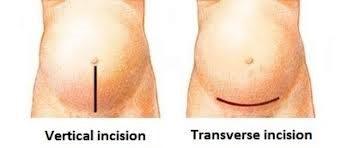
The most common incision for a C- Section is made horizontally (often called a bikini cut), which is just above the pubic bone. The incision is cut through the lower abdomen at the top of the pubic hair just over the hairline. The muscles of the stomach are not cut but they are pulled apart so that the doctor can gain access to the uterus. In an emergency cesarean the incision will most likely be a vertical incision (from the navel to the pubic area) which will allow a faster deliver. The surgeon also pulls the bladder down to protect it during surgery. Scarring from the incision builds up underneath the incision as well as in the uterus. As the c-section scar starts to heal and the uterus reduces back adhesions form.
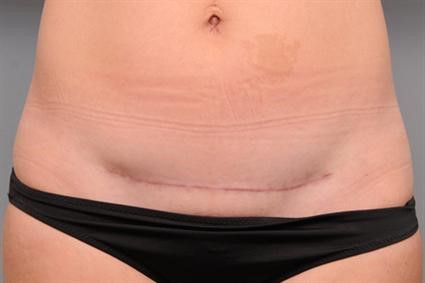
Scar tissue after a C Section is not preventable. Scar tissue is fibrous tissue that replaces normal tissue after an injury. While it contains the same materials as normal tissue, the quality of the scar tissue is inferior to that of the tissue it replaces. It is very important to understand that the scar that you can see is actually only the tip of the iceberg. All surgeries involve multiple layers of sutures and go much deeper than just the visible scar on the surface.
Another significant factor to be considered is the effect of adhesion formation on the internal organs. The organs are supposed to slip and slide around each other. Organs need this movement in order to function properly. When adhesions are present, the sliding surfaces stick to each other and drag across one another causing tensional pulls. The resulting restrictions can cause limited range of motion and pain in other areas of the body.
It can take up to two years after a surgery or trauma to fully heal. Pain and issues may not even surface until well after the Mom has “recovered” from the surgery. Years can pass and by then, the symptoms may not be associated with the scar.
Common complaints after a c-section can include sensitivity of the scar itself and nerves being caught up in the scar tissue causing itching, hyper or hypo sensitivity. This will make pants irritating or leave the Mom unable to feel anything from the scar to the pubic bone. Leaning over to pick up baby can be painful. The tensional pull from the scar may cause postural changes, that along with a decrease in the support of the back from the abdominal muscles could result in back pain. The scarring can cause the adjacent muscles to develop trigger points that refer pain to areas like the clitoris or urethra.
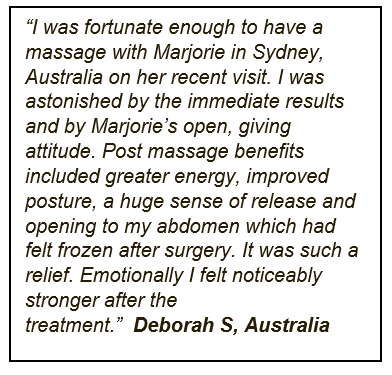
There can be issues with lower digestion such as irritable bowel syndrome or constipation and bloating. Adhesions around the uterus, bladder and fallopian tubes can lead to painful intercourse, frequent urination and fertility challenges.
Let’s not forget the emotional issues that can arise as a direct result of the scar. There is the self–consciousness about the appearance of the scar. Some women will not touch the scar and surrounding area. A simple pull or pressure on the scar can cause a continual minor or a sudden major PTSD reaction. Lack of sleep and mental stress from chronic pain that doctors do not acknowledge and family members do not understand can be detrimental.
Scar tissue can have an adverse effect on every one of the bodies systems. They are interconnected and encased by the fascia and the smallest of restrictions can cause problems. The good news is that there is much that can be done to minimize and correct the issues.
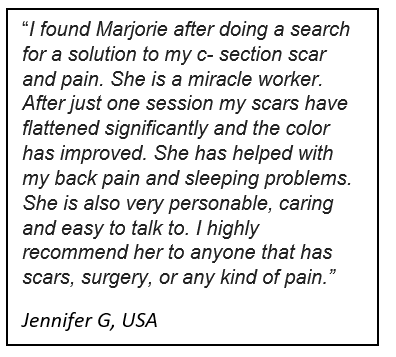
C-section scarring can be improved or corrected altogether by releasing the tissue and proper therapeutic rehab (every expecting mother needs to be trained in pelvic floor exercises for both pre & post pregnancy). As the scar tissue is released layer by layer, and fibers encouraged to lay down in the proper alignment, the tissue will become softer and function can be restored to the tissue surround the area. This reduces tensional pulls and reduces the adhesions. The tissue needs to be released in all directions, proper circulation (lymph included) restored, range of motion and body mechanics re-established.
The body needs time to heal, so for the best results light therapy such as myofasical release and lymphatic massage can start right after the surgery. Gentle range of motion stretching and proper body mechanics (how to feed, pick up and carry the baby etc) should be done in accordance with the mother’s ability and healing. After 12 weeks the tissue can be released via the STRAIT (Scar Tissue Release And Integrated Therapies) Method a three-dimensional, fascial-release system that works to minimize scar-tissue development and the subsequent physiological restrictions. As tissue is forever remodeling there in no time limit to working on scars. A difference can be made and balance restored no matter how old the scar is.
- William’s Obstetrics Twenty-Second Ed. Cunningham, F. Gary, et al, Ch. 25.
- Centers for Disease Control and Prevention www.cdc.gov
- World Health Organization http://www.who.int/
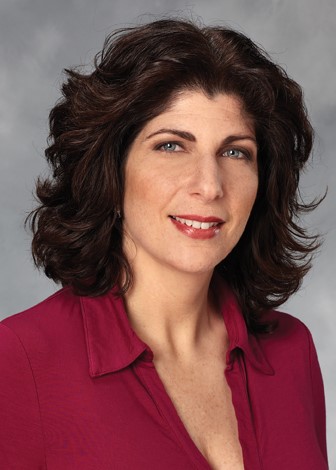
| Marjorie Brook is a International Instructor/Therapist. She is the creator of the S.T.R.A.I.T Method, a specialized therapy for fascial scars & adhesions. She travels around the world offering continuing education courses in Scar Tissue Release, Stretching and Strengthening, and Body Mechanics through her company at www.marjoriebrookseminars.com. Marjorie’s private practice is located in Wantagh, New York. |
